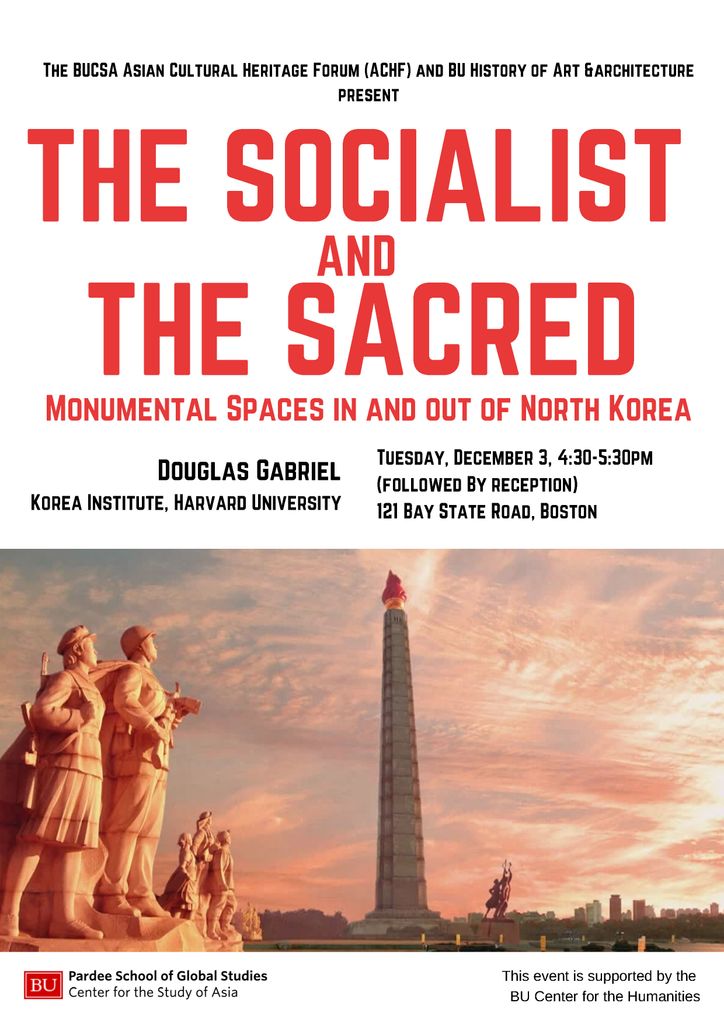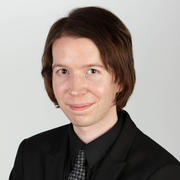The Socialist and the Sacred: Monumental Spaces In and Out of North Korea, Lecture by Douglas Gabriel (Dec. 3, 2019)
The BU Center for the Study of Asia, the Department of History of Art and Architecture, and the BU Archaeology Program invite you to join us for a fascinating upcoming lecture by
Dr. Douglas Gabriel
(Korea Institute, Harvard University)
Tuesday, Dec. 3, 2019 4:30-5:30 pm
at the Pardee School of Global Studies, 121 Bay State Road,
Boston University
with a reception to follow

We are pleased to acknowledge that the Asian Cultural Heritage Forum lecture series is generously supported by the BU Center for the Humanities.
About the speaker:
 Dr. Douglas Gabriel is the Soon Young Kim Postdoctoral Fellow at the Korea Institute, Harvard University. His current research is entitled Over the Mountain: Realism Towards Reunification in Cold War Korea, 1980–1994. As is described on the Korea Institute’s website, Douglas received his Ph.D. in Art History from Northwestern University in June 2019. His dissertation, Over the Mountain: Realism Towards Reunification in Cold War Korea, 1980–1994, examines connections between the visual art of the minjung democratization movement in South Korea and the work of state-sponsored artists in North Korea. During the late Cold War period, he demonstrates, artists on both sides of the peninsula employed various modes of realism in order to advance the project of reunification through aesthetics. These artists envisioned a reunited Korea founded on three primary thematic supports: student activism, socialist collectivism, and nativist iconography. Collapsing art historical distinctions between propaganda and politically engaged art directed against capitalism, they approached the issue of reunification in more dynamic ways than the two Korean governments, which remained preoccupied with superficial spectacles of national homogeneity.
Dr. Douglas Gabriel is the Soon Young Kim Postdoctoral Fellow at the Korea Institute, Harvard University. His current research is entitled Over the Mountain: Realism Towards Reunification in Cold War Korea, 1980–1994. As is described on the Korea Institute’s website, Douglas received his Ph.D. in Art History from Northwestern University in June 2019. His dissertation, Over the Mountain: Realism Towards Reunification in Cold War Korea, 1980–1994, examines connections between the visual art of the minjung democratization movement in South Korea and the work of state-sponsored artists in North Korea. During the late Cold War period, he demonstrates, artists on both sides of the peninsula employed various modes of realism in order to advance the project of reunification through aesthetics. These artists envisioned a reunited Korea founded on three primary thematic supports: student activism, socialist collectivism, and nativist iconography. Collapsing art historical distinctions between propaganda and politically engaged art directed against capitalism, they approached the issue of reunification in more dynamic ways than the two Korean governments, which remained preoccupied with superficial spectacles of national homogeneity.
In addition to completing a manuscript based on his dissertation research, Douglas looks forward to continuing work on his second book, The Last Pioneers: Communist Youth Culture and Contemporaneity in North Korean Art, 1945–2011. In this project he explores how North Korean artists mobilized visual representations of youth in an effort to grapple with the DPRK’s precarious standing vis-à-vis the international community at historical turning points such as Soviet de-Stalinization in the 1950s, and the fall of communism in Eastern Europe in the late 1980s and early 1990s. The book challenges perceptions of North Korea as chronically out of time with the rest of the world. It argues that the seemingly anachronistic appearance of North Korea’s youth culture yields insights on the lingering political anxieties and ideologies that underpin conceptions of what it means to be contemporary.
Douglas’s research on North and South Korean art and architecture has appeared in the Journal of Korean Studies and Hyŏndae misulsa yŏngu [Korean Journal of Contemporary Art History].